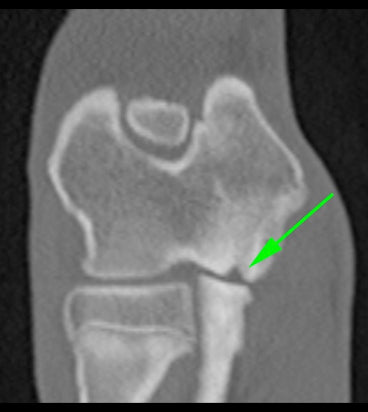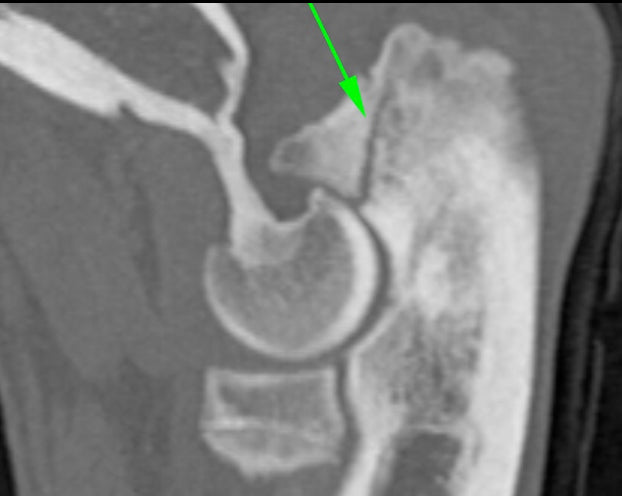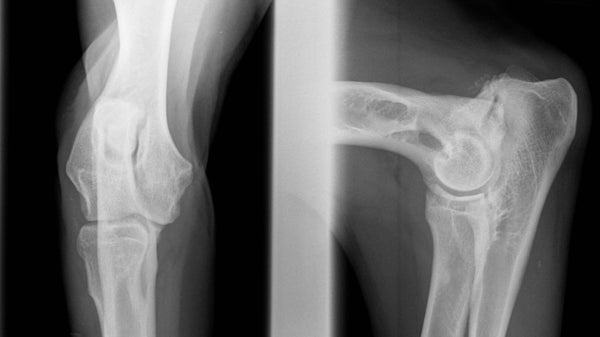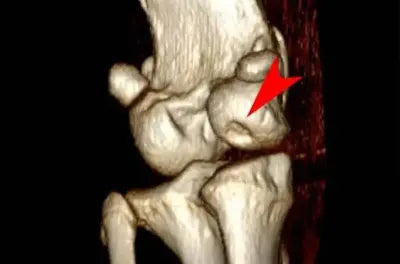No Products in the Cart
Is Your Dog Prone to Elbow Dysplasia? Symptoms and Best Treatments

Hi Jope's squad !
You’ve probably heard about hip dysplasia if you’re part of our Jope Squad, but did you know elbow dysplasia (ED) can also affect your dog? Below, we explain which breeds are prone to this disease, how the symptoms are diagnosed, and the best treatments.
Elbow dysplasia take-home messages
- Elbow dysplasia is a generic term meaning the abnormal development of the elbow joint.
- Elbow dysplasia includes several conditions, all of which are responsible for an arthritic evolution.
- The treatment is often surgical and allows the improvement of the clinical signs.
- Supplements can help in the long term.
- Arthroscopy allows the diagnosis and treatment of the underlying condition at the same time.
- Arthroscopy is a minimally invasive procedure that allows for a faster post-operative recovery.
- Early treatment is associated with a better prognosis.
What is dog elbow dysplasia?
Canine elbow dysplasia is a developmental problem . It can cause lameness, especially in young, large-breed dogs. Unfortunately, dog elbow dysplasia is often bilateral. That means it usually affects both sides of the body.
Some breeds are predisposed to this condition. If you have a Boerboel, golden retriever, Labrador retriever, or certain other breeds, your dog could be at risk of developing these symptoms. Below, we list the dog breeds that are most at risk of elbow dysplasia. But if you want to find out if your pup is on this list right away, jump ahead to our breed list.
As we explain in this overview, ED is not an easy disease to understand. And it is in part due to the fact that dog elbow dysplasia includes four different conditions. Osteochondritis dissecans (OCD), ununited anconeal process (UAP), fragmented coronoid process (FCP), and joint incongruity are the four ED types.
So, if you’re wondering how to tell if your dog has elbow dysplasia, read on! We share key facts about each of these ED types. Take your time to read through this overview. And most importantly, don't worry if you still have questions about elbow dysplasia after reading these facts. We're on a mission to keep dog owners informed!
1. Osteochondritis dissecans (OCD)
If your dog has the OCD (See Picture 1 below) type of elbow dysplasia, a small part of their cartilage has partially or completely detached from the joint near the middle of their outer humerus bone. This detached tissue then leads to joint inflammation and pain. Labradors, golden retrievers, Bernese mountain dogs, and Rottweilers are especially prone to this condition.
2. Fragmented coronoid process (FCP)
For dogs with FCP (see Picture 2 below), a small bone fragment at the inside of the elbow joint has detached from the ulna—the main bone of the lower leg. This cracking causes joint inflammation of the synovial fluid (synovitis). Also, it irritates the joint surface, eroding cartilage in the humerus—the upper part of the leg. The same dog breeds are prone to this type of elbow dysplasia as OCD. Labradors, golden retrievers, Bernese mountain dogs, and Rottweilers are at risk for this condition.
3. Ununited anconeal process (UAP)
UAP (See Picture 3 below) causes a bone fragment at the back of a dog’s elbow not to fuse properly with the ulna during growth. Normally, this fusion happens when a puppy is about 16 weeks old. Again, large-breed dogs are prone to this elbow dysplasia type. German shepherds, Basset hounds, mastiffs, and St. Bernards are all at risk.
4. Joint incongruity
Dogs with elbow incongruence have poorly formed or imperfect joints. Because their joint cartilage erodes fast, their joint surfaces don’t fit together properly. As a result, these dogs can develop osteoarthritis. ( See Picture 1. )

Picture 1 - An arthroscan of the elbow of a six-month-old dog that had been limping. The green arrow show the OCD changes your veterinarian will look for in a CT image. (Toulouse Veterinary School)
What causes elbow dysplasia in dogs?
As a concerned pet parent, you’ll definitely want to know where dog elbow dysplasia comes from. So, what risk factors are associated with this disease? And how can you prevent them? Again, remember that ED is a complicated disease. For that reason, we’ll cover some basic facts.
Canine elbow dysplasia is a disease that’s partly hereditary. It’s linked to a large number of genes. However, some animals that carry these genes never have symptoms. And because of this variation, selective breeding can’t easily prevent this disease. Also, external factors affect the appearance of dogs’ elbow dysplasia. These factors include puppies growing up too fast, intense physical activity, and even unnecessarily high-energy diets.
What Dogs Are Prone to Hip Dysplasia?
In 2017, a group of scientists published an important study about Hip and Elbow dysplasia in breed selection. They identified the top 15 breeds affected by this disease.
|
Dog breeds |
Elbow dysplasia rates |
|
Chow chow |
48.6% |
|
Rottweiler |
38.1% |
|
Bernese mountain dog |
26.0% |
|
Chinese shar-pei |
24.0% |
|
Newfoundland |
22.7% |
|
German shepherd |
17.8% |
|
American Staffordshire terrier |
16.1% |
|
Irish water spaniel |
15.6% |
|
English setter |
14.2% |
|
Bullmastiff |
14.2% |
|
Tibetan mastiff |
13.8% |
|
Mastiff |
13.1% |
|
Bloodhound |
13.1% |
|
Gordon setter |
12.6% |
|
English Springer |
12.5% |
What are the signs of canine elbow dysplasia?
Is your dog limping and favoring one or both of its front legs? This kind of limping is a telltale sign of elbow dysplasia in dogs. In ED, this limp tends to vary in severity, and it’s often aggravated during exercise. So, how likely is it that your dog has elbow dysplasia?
In general, ED causes lameness in young, large-breed dogs. The signs and symptoms tend to show up very early, when puppies are just five to eight months old. Sometimes, owners will notice a change in their dog’s posture. This change is easy to recognize because the feet turn outward, like a duck’s. Sadly, dogs with severe elbow dysplasia in both elbows tend to refuse to exercise. Instead, they prefer lying down most of the time to avoid pain.

What should I do if my dog can’t walk?
If your dog has lost the proper use of their front legs, bring them in to see your veterinarian. And if your dog is around five to eight months old when this happens, your vet will suspect the symptoms of elbow dysplasia.
First, your vet will perform an orthopedic exam. Next, they’ll take some x-rays of your dog’s elbows. In some cases, they might also recommend a CT scan of your pup’s elbows. This added step can help confirm any ED signs that come up during the exam and x-ray.


Then, based on their findings, your veterinarian might propose elbow arthroscopy or another surgery. These treatments for dog elbow dysplasia require anesthesia. And depending on your pet’s unique case, the surgery might take place on the same day as the exam. Alternatively, your dog’s surgery could be scheduled for a later date.
How is elbow dysplasia diagnosed in dogs?
Fortunately, dogs can live with elbow dysplasia. However, like with most diseases, early diagnosis is important. Early treatment helps achieve a better prognosis for your dog. Also, it’s important to understand that only a veterinarian can diagnose elbow dysplasia in dogs.
An ED diagnosis is based on several key factors, including:
- Your dog’s breed
- The signs and symptoms you’ve noticed
- Your dog’s gait and posture
- Orthopedic and radiographic exams (or even CT scans)
Often, because x-rays are affordable, they’re performed early on when your vet suspects a case of dog elbow dysplasia. Although you can’t see cartilage in x-ray since it isn’t mineralized, x-rays show the joint and its surroundings. So, x-rays can help diagnose elbow dysplasia. For that reason, vets use elbow x-rays as a first step to diagnose the four types of ED: UAP, OCD (sometimes), FCP, and joint incongruity.
Also, if your vet suspects FCP or OCD in your dog, they might suggest arthroscopy. This treatment can allow vets to diagnose the disease while treating the damage at the same time. Elbow arthroscopies and other specialized procedures are mostly performed by board-certified surgeons (members of the American College of Veterinary Surgeons—the ACVS).

The best treatments for dog elbow dysplasia
A few treatment options are available for dogs with elbow dysplasia. The best treatment for your dog depends on the severity of their ED. One option that your vet might recommend is medical management. This is a good option for dogs whose ED is either very mild or so severe that the joint won’t likely benefit from surgery.
However, vets usually recommend surgery as the best elbow dysplasia treatment for dogs. That’s because it’s beneficial in most cases—especially with an early diagnosis.
Your vet will explain the specific surgery that’s right for your dog. But you might be interested to learn that not all four ED types will benefit from the same surgery. For example, in the UAP case, an arthrotomy (opening of the joint capsule) is usually the best treatment. In this case, a surgeon will either remove the bone fragment or reattach it with a screw. Meanwhile, for FCP and OCD treatments, vets remove the bone fragment through arthroscopy. And for dogs with elbow incongruity, vets use a bone section (or sometimes several bone sections) to correct the problem.
So, how much does surgery cost to treat dog elbow dysplasia?
These procedures vary in price, but the cost usually ranges from $1,500 to $5,000.
Post-surgery treatments and care
Throughout a surgery, your veterinary team will care for your pet. They’ll focus especially on post-surgery pain management. If necessary, your dog’s medical team can prescribe opioids during their stay at the veterinary hospital. Your vet will also prescribe at-home medication since elbow dysplasia and recovery can be painful.
If you notice any lameness in your dog after their surgery, don’t be alarmed. Some limping is normal right after surgery. At first, their lameness might even increase or get worse. However, your dog will usually get better. The limping will generally stop around three weeks to a month after surgery. If your dog had an arthroscopy treatment, you’ll probably notice more immediate relief—and a more comfortable recovery. But it’s important to remember that recovery varies from dog to dog.

These medical devices help evaluate the joint surface to determine the extent of any damage. Also, they allow for three-dimensional reconstructions—a significant advantage. (See Picture 5).

Post-surgery care is very important. The proper treatment after a surgical treatment helps ensure benefits for your dog. So, during the six weeks after surgery, strict rest is a must. You should stick to short leash walks, and only when necessary.
It’s also important to understand that intense activity will reverse the benefits of elbow dysplasia surgery. And that can mean disastrous consequences for your dog! So, you should strictly avoid running, jumping, and playing after surgery. We strongly recommend asking your vet for physiotherapy advice. They’ll explain how to safely, gradually increase your dog’s activity.
Can dogs recover from elbow dysplasia?
As with all painful diseases that can affect your dog, you’re probably wondering about the outlook for ED. Can dogs with elbow dysplasia recover? According to some specialists, about 90% of dogs with FCP and 80% of dogs with elbow OCD benefit from surgery. Most dogs with UAP also recover after treatment. Approximately 60% regain their normal function, 30% get better, and 10% don’t improve.
Unfortunately, surgery doesn’t completely cure any osteoarthritis that’s present in the joint. As a result, some dogs may experience stiffness or lameness after heavy exercise or weather changes. These episodes are called an arthritis crisis. And sadly, dogs with severe joint inflammation or extensive cartilage damage have lower success rates after treatment.
At Jope, our goal is to guide you on a deep dive into your dog’s conditions. If you have questions, please feel free to email us.
Disclaimer: Our article (and any other website) does not replace your veterinarian’s advice or diagnosis. Indeed, your veterinarian is your best ally in taking care of your best friend! We can only give general advice. For more specific advice related to your dog's condition, please reach out to your veterinarian. Our UC-II product is scientifically proven to “help support companion animal's joint health and mobility” and “support joints and connective tissue, helping to improve flexibility and mobility for adult and senior dogs.”
During an osteoarthritis crisis, you’ll want to relieve your dog’s pain and inflammation. In the long term, veterinary-grade, high-quality pet supplements could help control your pet’s osteoarthritis. Did you know that Omega 3 and undenatured type II collagen are the only two molecules that have shown objective, positive results (measured with plate forces) for dogs with osteoarthritis?
Also Read - Is Turmeric (Curcumin) Helping Dogs With Osteoarthritis?
With the best treatments and the right prevention, dogs can live healthy lives despite elbow dysplasia. These tools include supplements, a good diet, and an early exam if your dog shows any ED signs or symptoms. We hope these dog elbow dysplasia facts helped you understand the disease and how to protect your pet.
FAQ
Is elbow dysplasia in dogs always genetic?
Yes. Elbow dysplasia is primarily a genetic condition caused by abnormal development of the elbow joint, especially in large-breed dogs. However, factors like rapid growth, poor nutrition, and excessive exercise at a young age can make it worse or cause symptoms to appear sooner.
What is the success rate of elbow dysplasia surgery in dogs?
Surgery for elbow dysplasia is often successful, especially when done early and followed by rehabilitation. Arthroscopic surgery has shown improvement in mobility and pain relief in over 70 to 90 percent of dogs according to veterinary studies. Results vary by the dog’s age, condition severity, and post-op care.
How do you exercise a dog with elbow dysplasia?
Gentle, low-impact activities like leash walks on soft surfaces and controlled swimming can help maintain strength without stressing the joints. Avoid running, jumping, or rough play. Always consult your vet or rehab specialist to create a tailored plan for safe, joint-friendly movement.
















Leave a comment